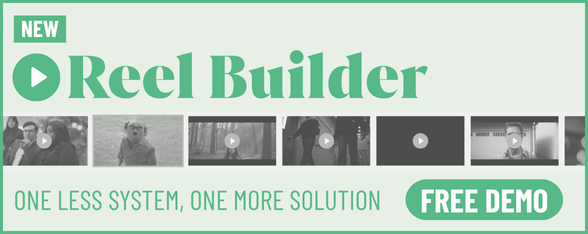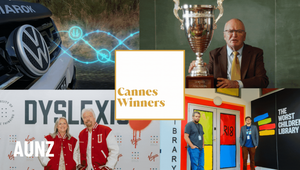
What the Flack: Ian Benet

Ian Benet started his career in media at age 11 as a paper boy, delivering papers around town and getting the news spread far and wide, he hasn't stopped working in the world of public relations since.
In 2008, he was a PR trainee for MHW Public Relations, fast forward to 2011 Ian found himself the the PR Account Manager at Cool Blue in the UK. He then traveled to New Zealand and worked as DDB Group Asia Pacific's account director and TBWA's client partner.
Today, he calls New Zealand home and is the general manager of Eleven PR.
LBB> Tell us about your current role and what you do?
Ian> I’m general manager at Eleven NZ, part of the TBWA\NZ Group. I support and coach the team to develop and launch great campaigns for a huge range of awesome clients. But as the title suggests, it’s really a bit of everything. It’s having an eye on finance and revenue, shaping the working environment and deciding where to concentrate resources to provide the best outcomes for the team, our clients, and the wider agency.
LBB> And how did you get to where you are today?
Ian> Hard work, a bit of serendipitous luck but mainly a lot of support and encouragement when I was growing up. Despite having three kids’ under-five my mum spent a lot of time ensuring I could read and write before I went to school. I had some great teachers that aroused a curiosity in subjects like history, sociology, and English, all helpful for a PR career. Then as a young AE I received a lot of guidance on finding news angles, creative writing, and not sweating the small stuff. I wasn’t always the best student, I’m a little too stubborn for my own good, but I’m incredibly grateful for all the support I received and try to pass it on as much as possible.
LBB> What does your average day look like?
Ian> Eleven has clients in nearly every category so as the cliché goes, no day is the same. Part of the job I’ve always enjoyed is learning about individual businesses and the category in which they operate.
I spend a lot of my day working through projects with the Eleven team and wider TBWA\NZ Group. It could be providing an earned lens to support integrated creative and social ideas or working through a new business pitch. Eleven NZ tends to work across the network, both in New Zealand, Australia and further afield with the TBWA FROM NOWHERE team, who are currently based in London. It’s very collaborative with expertise, ideas and knowledge coming from all parts of the organisation.
LBB> For your organisation, what is the key function of PR and comms? Is it about company culture? Attracting clients? Empowering talent? Something else?
Ian> Eleven supports the TBWA\NZ Group drive fame for its clients through creativity. We look at each idea from an earned and social perspective to see how it could deliver cultural impact and achieve the objectives of the client brief.
And when the work is good, people outside the organisation take notice. That inturn does all the good stuff like attracting clients and talent. When going well it becomes a bit of a virtuous cycle that supports the growth of the agency.
LBB> PR has always been about finding the story / finding the angle. What is your process for staying ahead of the content curve and serving up something fresh and engaging?
Ian> Read lots and read widely. Sit in doctors waiting rooms and read magazines, even the ones that you have no interest in. Buy the local paper in whatever city you’re visiting and read it front to back. Keep the social media algorithm guessing by exploring new trends and themes and niches on social media. Pay attention to what people are saying and consider how wider trends in culture can be harnessed for clients. This is where the TBWA proprietary tools come in handy, Backslash and Edges are fantastic resources for identifying trends and movements in culture. It’s a source of stimulus and ideas and ensures despite being at the bottom of the world we know what’s happening in some of the most vibrant and colourful cities the world over. And just get out of the agency bubble as much as possible.
LBB> Historically Advertising folk have a very different relationship with the media, especially the press, than PR folk. Advertising is about buying ad space and being able to dictate how and where something is presented - that’s a degree of control you can barely dream of in PR. Does that tension still exist, and if so how do you navigate that tension?
Ian> It’s not as cut and dried anymore, as media channels shrink and pay-to-play becomes more prolific, there are so many channels available now and new ones emerging daily. I wouldn’t call it tension, it’s more about digital blending and cross-discipline collaboration to deliver the best results - it’s more about the audience, and how best to reach them.
LBB> And what other common misconception do you advertising/production people have about comms and PR?
Ian> That their creative idea is guaranteed to be of interest to time-poor journalists, but that’s understandable, we naturally believe in, and are proud of our own ideas. A big part of my job involves working with the wider agency teams to shape creative ideas into campaigns that will be of interest to the media.
LBB> To what extent do you feel ‘the work speaks for itself?’ To what stage of growth can a business rely on this mantra to gain more clients?
Ian> The best ideas are creative PR ideas, these are the ones that get the most cut through, word of mouth, and traction - if an idea is based on a cultural insight, and then addresses or solves a real world problem, then yes, the work can speak for itself - and these are the ideas that we focus on creating at Eleven.
LBB> When it comes to getting coverage/PR for a creative campaign in the consumer press, how should creative teams go about working with their agency’s comms and PR experts?
Ian> Bring the PR team in nice and early. Get them across the initial strategy and creative thought starters. Work with them to shape an idea and build it out from an earned perspective. Discuss and consider why a third party would be interested enough to write about it or share it on their own channels. What’s in it for the consumer?
LBB> When a business is faced with very bad news, what’s the key to getting through it?
Ian> To rally round, to support one and other, to take a breath then plan and develop a strategy to get through it. I’m a big fan of the A.R.C. (Assess, Resolve, Control) methodology employed by FleishmanHillard. Too many brands jump straight to resolve without taking the time to properly assess the situation and end up in all sorts of bother.
LBB> Generally speaking, how do you approach the hack/flack relationship?
Ian> Building positive relationships remains key. I always tell the team to remember that journalists are humans too and just like us are working in high-pressure environments. Consider what they need, what their beat requires and how you can make their lives as easy as possible.
LBB> How does doing comms/PR for the advertising world differ from any other industry you’ve worked in?
Ian> My first job was as a paper-boy aged 11, I used to read the papers front to back on my round, everything from The Daily Telegraph to the Daily Sport. It was an interesting round. It prepared me well for early mornings and getting a feel for what makes a story. After that I had a variety of weekend and holiday jobs, from working in McDonald’s, to running the student bar and working for a bouncy castle operator. Even all these years later I would say PR offers more variety and experience opportunity than most roles.
The key difference is we always aim to create purpose-led ideas and work that is culturally relevant - our key focus is creating something that will cement a brand’s place in culture. That way we’re driving interest and creating the news, not just reading it like I was aged 11.
LBB> What are the most useful tools in the arsenal of a PR / comms professional working in advertising / creative industries right now?
Ian> Right now, at TBWA\NZ it is the GenZine, a comprehensive guide to the language and lingo of Gen Z. Personally endorsed by Paris Hilton and created by some talented young creatives, it has been incredibly useful for helping me stay tapped into popular culture and understand what’s being said around the office. Slay!
Aside from that I’m a big fan of TBWA’s Backslash tool. It’s great for identifying cultural shifts, emerging trends and just generally being a creative thought starter. It has sparked many wild, wonderful and award winning ideas.
LBB> In your opinion, how has the role of a PR / Comms professional evolved during your career span ? Have things changed greatly or do core tasks / principles remain the same?
Ian> It is much more focused on content and social than when I started. My university was one of the first in the UK to launch a social media module and I was on the first intake. We all had to create ‘The Facebook’ profiles. Facebook might not be what it once was, but the demands of social media and content are now a huge part of any campaign and something all PR professionals need a very good understanding of.
LBB> What frustrates you about the way the media and PR have changed over the years?
Ian>The shrinking media pool and the rate at local media companies are closing or amalgamating. I fully support any media title that puts its content behind a paywall.
LBB> And what excites you?
Ian> Gaming has finally been recognised as deserving of its own category at Cannes. Gaming is often dismissed and underrated as a medium and an industry but it’s massive. Online gaming attracts a larger audience than radio, podcasts, TVOD or music in the 15-24 age group and is full of opportunity for brands amongst hard-to-reach demographics. We’ve delivered some incredible and award winning campaigns for PlayStation but I feel we’ve barely touched the surface of what’s possible.















